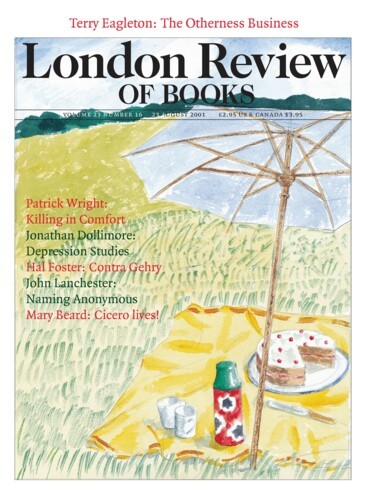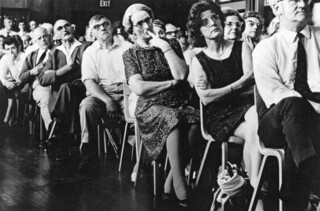Work by 18 of the photographers with whom John Pilger has collaborated over the last thirty or forty years is on show in Reporting the World, at the Barbican Gallery until 30 September. The exhibition is a record of events we remember – vaguely or clearly – having followed and others that we didn’t follow, even if we tell ourselves now that we did. The themes, inevitably, are death, upheaval, dismay and tension in a dozen places or more, the furthest probably Alice Springs, the closest probably Wolverhampton. In most of the locations we’re taken to extremes, but not left stranded. There’s plenty of explanatory text, as there was when these photos originally appeared alongside Pilger’s copy. Some of the most striking pages from the Mirror, the Guardian and the New Statesman are enlarged and hung here, most memorably the ‘world exclusive’ from Cambodia in 1979, after the Khmer Rouge had abandoned Phnom Penh to the Vietnamese Army. The opening paragraph on page one of the Mirror, under a close-up of three blanched skulls taken by Pilger’s colleague Eric Piper, talks of a society consigned to ‘an age of slavery, without families and sentiment, without machines, schools, books, medicine, music’. The pages themselves seem old, the events not nearly old enough.
The photos from Cambodia are among the most memorable. Pilger and Piper – and two film-makers – arrived in Phnom Penh in July to find that the Khmer Rouge had blown up the National Bank on their way out a few months earlier. Monsoon rains flooded the gutters with banknotes – hungry children dried them out and tried to burn them under cooking-pots full of roots and leaves. Despite the powerful animating presence of children as victims and survivors – a recurring motif of war reporting – the feeling is one of desertification, of a city swept bare of people. A drab room in an old school, which the Khmer Rouge turned into a jail, contains a metal bedstead: a kind of rack, surrounded by blood and tufts of hair. Years later, Nic Dunlop, another of these enterprising photographers, tracked down one of the men who ran the jail. Dunlop had been carrying round a photo of his quarry for a long time, and had no trouble recognising him: a born-again Christian in an American Refugee Committee T-shirt, his expression, in the one print here, somewhat closer to anxiety than regret. He’s now awaiting trial in Cambodia for crimes against humanity.
One of the virtues of this exhibition is that Pilger says something informal and revealing about the people he’s been on assignment with. The best of his remarks are not to do with their courage (that’s plain), but their wit, their foibles and passions. And so old Eric Piper, who photographed the bed, and the fistfuls of worthless banknotes, turns out to have lugged his cameras about in plastic airline bags by way of ‘disguise’, and to have had an ‘understanding’ with the Mirror that he’d get to cover the winter cricket, or royal jamborees, preferably in warm countries. ‘Among his achievements was persuading Princess Anne to transform her expression of totemic disdain into a human smile.’
Yet the photos themselves aren’t entirely silent about their makers. You can see the sensibility as it’s been at work on site and in the dark room. Philip Jones Griffiths presents a street scene in Saigon (1970) where a lumbering GI is having his pocket picked by a young girl as a fable about power and guile, and the impending American defeat. The best of John Garrett’s photos, taken in the UK, show an extraordinary attention to the surroundings of his subjects. To textures in particular: the brickwork of a Durham Labour Exchange, or the paint peeling from the walls of a terrace in Liverpool with a lavishness that suggests the rotting wharves of an imperial outpost in the tropics (and so, in a single frame, the history of the city is evoked); a woman under an umbrella treads the pavement in front of the terrace. Garrett’s Enoch Powell, photographed in 1970, is a gifted snake-oil salesman, with a touch of Olivier in The Entertainer, grinning over a hustings portrait of himself. In another shot, his rapt audience all incline to the right under the prevailing wind of oratory. A strong gust, one imagines, will deck the lot of them.
It’s Pilger’s hope that these pictures may ‘offer inspiration to a new generation of eyewitness photographers’. But Reporting the World is also a tribute to his editors – the nurturers and tough guys, authorisers of fantastic foreign travel tabs – who had the trust of their proprietors, or the confidence to face them down, and, as Pilger says, things have changed. The growth of ‘lifestyle’ coverage has seen ‘the bottom drop out of photojournalism’. Nowadays, the young freelancer’s best chance of an eyewitness scoop is to catch one kind of celebrity choking on a piece of complicated salad prepared by another kind of celebrity in a restaurant whose main courses can be seen in colour in the having-and-spending section, or maybe on the paper’s website. While you’re there, spare a thought for the person who lit and shot that beguiling garlic press in brushed aluminium – available in Heal’s – and who wanted very much to be somewhere else at the time.
Send Letters To:
The Editor
London Review of Books,
28 Little Russell Street
London, WC1A 2HN
letters@lrb.co.uk
Please include name, address, and a telephone number.


